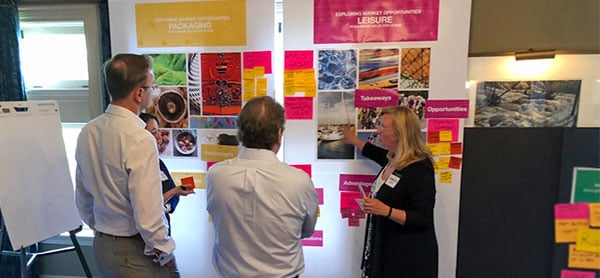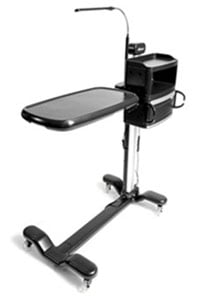Nottingham Spirk’s PathFinder™ white space analysis program helps companies launch new businesses—and it isn’t just for those struggling.
Writing about category strategy in Harvard Business Review, advisers Peter Yoon and Parker DeRensis warned against the false sense of security that can affect even the undisputed king of a crumbling mountain.
The primary problem with a category domination strategy, they write, “is it encourages managers to focus most of their attention on market share and not enough on the category itself. It assumes your category will continue to be relevant and grow so you can be a big fish in a big and growing pond. But what happens when your category is not growing—or even declines? Being number one in a declining market isn’t a great place to be.”
And that’s just one of many situations that can leave a company—even a seemingly successful one—vulnerable to declining revenues, loss of market share, or both. Hubris, complacency and indecision all have the same effect: stagnation.
Nottingham Spirk’s PathFinder™ white space analysis program is designed to help a company of any size, in any industry, disrupt its own business before a competitor can. In the three to four-month program, NS associates and partner-client representatives work side by side in a process that starts off wide open, looking at up to 10 possible new categories. We then systematically identify specific pain points that markets have not addressed, narrowing the field of options and uncovering the best solutions that the business can develop for immediate action.

Above: A workshopping session led by Nottingham Spirk uncovers opportunities for innovation.
The primary problem with a category domination strategy, they write, “is it encourages managers to focus most of their attention on market share and not enough on the category itself. It assumes your category will continue to be relevant and grow..."
The entire process reflects a clearly defined business strategy, agreed upon from the outset. Here are some of the most common circumstances that have prompted companies to seek our help.
1. You need to diversify your product portfolio or add a revenue stream
 Laszeray, a contract manufacturer of high-end injection-molded plastic components, tooling and assemblies, has grown steadily thanks to key partnerships to provide intricate components for a diverse portfolio of consumer, medical and industrial product companies. Strategically, Laszeray’s leaders recognized how much more valuable they would be to the market if they utilized their skills by optimizing internal core competencies around the entire process of product development. They came to NS to uncover markets that drew on their expertise and transition into building proprietary products while not creating competition for their main customers.
Laszeray, a contract manufacturer of high-end injection-molded plastic components, tooling and assemblies, has grown steadily thanks to key partnerships to provide intricate components for a diverse portfolio of consumer, medical and industrial product companies. Strategically, Laszeray’s leaders recognized how much more valuable they would be to the market if they utilized their skills by optimizing internal core competencies around the entire process of product development. They came to NS to uncover markets that drew on their expertise and transition into building proprietary products while not creating competition for their main customers.The result was the atHand Overbed Table System, the first modular overbed table with built-in lights, power, USB and storage. NS’s research revealed that there had been little to no innovation in the overbed table market, despite the trends toward more home healthcare and aging in place. The product has earned mostly four- and five-star reviews from Amazon purchasers, and Laszeray has rolled out additional parts and accessories. The successful venture demonstrated their ability to think strategically and innovate, giving them a competitive edge with prospective clients.
NS is currently working with a packaging company that, at first, just wanted help solving a manufacturing dilemma. Then partnered on a new product within its category. Most recently, NS has identified opportunities in wholly separate categories, areas where competitors are unlikely to follow, but that would require new manufacturing processes. The company has not moved on those yet, but now has the knowledge that these are viable markets to move on when the time is right.
2. You’re a B2B that wants to break into B2C
NS worked with Cardinal Health, a world leader in integrated healthcare services and products, on the InPower Connected Personal Medication Assistant. The first-of-its-kind health and wellness device combines medication adherence, an issue with enormous impact on health outcomes and costs, with biometric response.
Like Laszeray's atHand table, the InPower is Cardinal Health’s first consumer-facing offering. But instead of a material, the starting points in this case were Cardinal Health’s deep roots in the healthcare ecosystem; its vast distribution network among pharmacists, healthcare providers and hospitals; and its capacity to innovate from a “data first” perspective.

Above: The InPower Connected Personal Medication Assistant
3. You want to attract new investment or financing
When Stanley Black & Decker acquired a 20 percent stake in MTD Products Inc., Stanley’s CEO cited MTD’s “commitment to innovation” as one of the key reasons for making the deal. Among MTD’s recent innovations are the Troy-Bilt FLEX modular yard care system, winner of an Edison Award and one of several products developed with NS; and the Cub Cadet Hauler, a versatile two-wheeled yard cart that addresses storage concerns: four collapsible sides allow the Hauler to be folded flat and stored vertically, taking up 70% less storage space.
The ability to innovate disruptively—not with incremental tweaks to existing lines but by expanding into adjacent categories or, even better, creating new ones—is a powerful variable in a company’s worth. Innovating demonstrates qualities not reflected on a balance sheet, like an organizational willingness and capacity not just to adapt to market changes, but to force them.
4. You’re in danger of disruption
You may be familiar with the story of the invention of digital photography, in Eastman Kodak’s labs in the 1970s. But reluctant to develop a product that would eat into its film and processing revenue, the company squandered its head start, slowly but steadily lost market share for years, and eventually filed for bankruptcy in 2012.
The larger the company and the older the industry, the greater the threat. But as the pace of technological advancement increases, every company runs the risk. Incremental innovations are best achieved by employees, but the elements necessary for disruptive innovation often run counter to company culture and processes.
In its Benchmarking Innovation Impact Report, Innovation Leader notes: “Survey respondents agree about the biggest obstacles to delivering impact for their organizations. The first is a group of challenges we dubbed ‘company politics, turf wars, or lack of alignment.’ The second most common obstacle was ‘cultural issues.’ For large corporations, infusing the culture with entrepreneurialism and risk-taking is extraordinarily challenging.”
It’s also important to remember that categories can be quite arbitrary. As Yoon and DeRensis noted in the HBR essay quoted earlier, “a ‘category’ is often inaccurately defined, which creates blind spots from unexpected competitors.” Category strategy is tricky because ultimately consumers decide who and what your competitors are. This is how protein bars became a problem for breakfast cereal manufacturers, how apps toppled the once-mighty Blockbuster retail chain, and how a quirky hip-hop tune shot up Billboard’s Hot Country Songs chart.
The larger the company and the older the industry, the greater the threat. But as the pace of technological advancement increases, every company runs the risk. Incremental innovations are best achieved by employees, but the elements necessary for disruptive innovation often run counter to company culture and processes.
5. You’re not aligned on strategy
There is such a thing as too many ideas. We recently worked with a client that was overwhelmed by the volume of viable concepts. They had identified several categories for new products but were struggling to narrow and prioritize the list. Their team and ours spent two full days deeply immersed in the data they’d collected, and—more important—identifying everything they had not considered, using human-centered and exploratory design processes facilitated by our certified executive coach. By the end, the choices were clear.
This company is staffed with smart, dedicated people and boasts an enviable record of bringing products to market. But they were so deeply immersed in their daily work that they lacked the capacity to truly step outside it. They needed equally smart and dedicated outsiders who would first spend the time to understand their market and their place in it, and then ask “why” with the persistence of a curious toddler. Some of the answers required research with fresh eyes, but others just needed to be excavated from beneath layers of knowledge and habit. This is why we continually and purposefully mix our project teams, to promote new thinking.
6. Change or be changed
Knowing that your technology or process could be applied in other industries is one thing; it’s quite another to spot opportunities in unfamiliar markets, decide which to pursue and map out the steps to get there. That shift must start with an honest and thorough assessment of where the organization is, where it wants to be and what that journey will entail.
 Like our Vertical Innovation® process for product development, PathFinder involves a multi-disciplinary team whose members are chosen according to the client-partner’s needs. These team members after only a short time have a vast perspective of the markets and can quickly offer sound, feasible solutions that meet the users’ needs.
Like our Vertical Innovation® process for product development, PathFinder involves a multi-disciplinary team whose members are chosen according to the client-partner’s needs. These team members after only a short time have a vast perspective of the markets and can quickly offer sound, feasible solutions that meet the users’ needs.
This is how we’ve disrupted markets since the 1970s when we helped a manufacturer of plastic bedpans transform into one of the world’s largest toy companies—Little Tikes.
How can we help you?
About us: Nottingham Spirk is a business innovation and product design firm with an unrivaled record of delivering disruptive consumer goods, medical devices, and packaging design solutions to market. We collaborate with Fortune 1,000 companies, funded start-ups and non-profit organizations to discover, design and execute product programs and strategic business platforms that will wow customers, grow markets and generate new revenue streams. Learn more about what makes us different.

